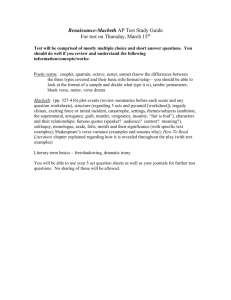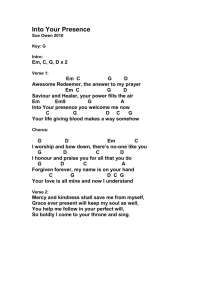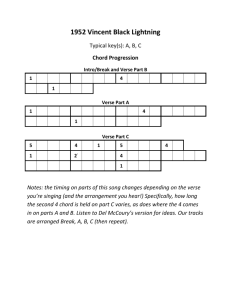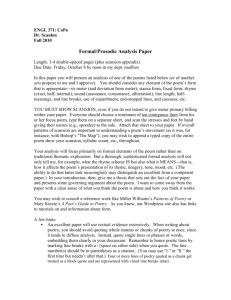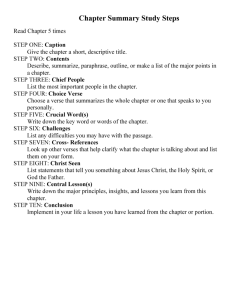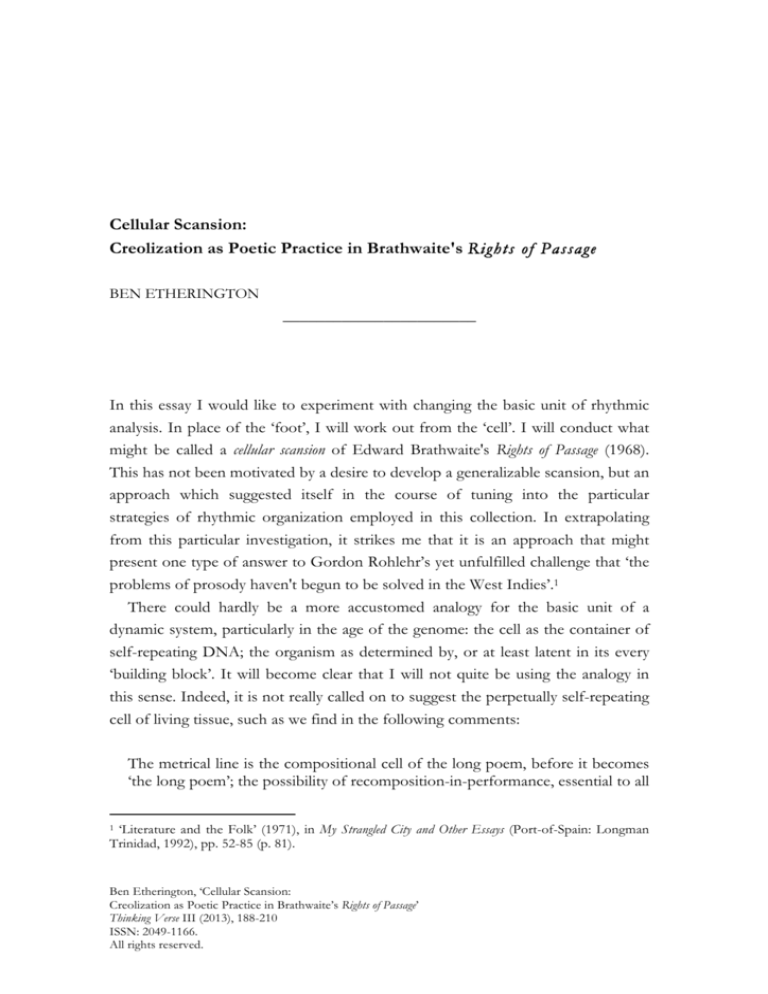
Cellular Scansion:
Creolization as Poetic Practice in Brathwaite's Rights of Passage
BEN ETHERINGTON
_______________________
In this essay I would like to experiment with changing the basic unit of rhythmic
analysis. In place of the ‘foot’, I will work out from the ‘cell’. I will conduct what
might be called a cellular scansion of Edward Brathwaite's Rights of Passage (1968).
This has not been motivated by a desire to develop a generalizable scansion, but an
approach which suggested itself in the course of tuning into the particular
strategies of rhythmic organization employed in this collection. In extrapolating
from this particular investigation, it strikes me that it is an approach that might
present one type of answer to Gordon Rohlehr’s yet unfulfilled challenge that ‘the
problems of prosody haven't begun to be solved in the West Indies’.1
There could hardly be a more accustomed analogy for the basic unit of a
dynamic system, particularly in the age of the genome: the cell as the container of
self-repeating DNA; the organism as determined by, or at least latent in its every
‘building block’. It will become clear that I will not quite be using the analogy in
this sense. Indeed, it is not really called on to suggest the perpetually self-repeating
cell of living tissue, such as we find in the following comments:
The metrical line is the compositional cell of the long poem, before it becomes
‘the long poem’; the possibility of recomposition-in-performance, essential to all
‘Literature and the Folk’ (1971), in My Strangled City and Other Essays (Port-of-Spain: Longman
Trinidad, 1992), pp. 52-85 (p. 81).
1
Ben Etherington, ‘Cellular Scansion:
Creolization as Poetic Practice in Brathwaite’s Rights of Passage’
Thinking Verse III (2013), 188-210
ISSN: 2049-1166.
All rights reserved.
Cellular Scansion
long poems before they are corralled first into orally standardized and quasiidentically recapitulated, then into written, and finally into printed texts,
depends for its possibility upon the formula, a unit which is at once metrical
and syntactic and semantic.2
The observation is being made that in non-print culture ‘content’ necessarily takes
the shape of its mnemonics, and so it would be pointless conceptually to separate
metric formula from the language matter it organizes. The possibility of separation
only arises when meter’s mnemonic function is rendered technologically
unnecessary by print.
Does this mean that the metrical cell inevitably becomes superfluous? Not
according to our commentator, who maintains that ‘a print culture of poetical texts
is always also at the same time an oral culture of verse rhythms’.3 Only if speech
itself were flattened of all intonational qualities to become pure grammar could the
syntax and semantics of the word be detached from rhythmicity. He insists that in
printed poetry: ‘The line […] is still the cell. It does not merely contain ideas that
the poet thought of earlier. It generates ideas, suggests them; the old formula
colonises and creates new thoughts.’4 This is not the same as claiming that meter
automatically generates new thoughts. If there is no ‘cooperative antagonism’ of
rhetorical design and metrical line, verse’s thinking falls limp.
The ‘cell’ analogy in the essay under discussion is not only metric, but meter is
presented as essential to that which makes the cell of the long poem ‘everexploding, ever-generating’ (609). Scansion, here, would not be a pseudolepidoptery that expects to pin down meter, but the attempt to articulate that limit
which enables a cell’s prodigality. To be successful, scansion’s concepts would
need to be as alive as verse practice. ‘Cellular scansion’ would therefore be a
proposal for a historicized scansion; a scansion attuned to the specifics of any given
metrical practice in the terms of the historical condition of the materials of verse
being employed, and which seeks to give an account of how a particular poem’s
line-cell is able to multiply and flourish.
Simon Jarvis, ‘The Melodics of Long Poems’, Textual Practice 24 (2010), 607-21 (p. 609).
Jarvis, p. 608.
4 Jarvis, p. 610.
2
3
Thinking Verse III (2013), 186-208
187
Ben Etherington
This is not quite the cellular scansion to be pursued here. The notion is
introduced in order to tune into the historicity of rhythmic practice in a location in
which the antagonism between meter and design is not necessarily deemed to be
fecund. Simon Jarvis employs militaristic and colonialist analogies to characterize
print’s ‘dialectic of melodics’: the murderous disposition (610) of line and design is a
war to life, lest the printed body become sclerotic (617), metrical formula colonizes and
creates new thoughts (610). The rhetoric is and is not hyperbolic. Meter, an
instrument of a reason prior to instrumental reason, must fight for life in
enlightenment’s internal war. Yet there is a playfulness, mocking at certain
melodramatic free verse polemics, which must characterize meter as oppressive in
order to recommend their own liberty. ‘And each in the cell of himself is almost
convinced of his freedom.’
It seems unlikely that Jarvis would have much patience for the following
comment on rhythm in Louise Bennett's ballads:
Prosodic achievement here had to be confined to the tension created through
the counterpoint of Jamaica Creole speech rhythms and the fixed metric cage of
the stanza.5
He might perceive the same flaw in another comment on Bennett:
The tyranny of the pentametre can be seen/heard quite clearly here, although
Miss Lou erodes and transforms this with the sound of her language. Its riddim
sets up a counterpoint against the pentametre: ‘River flood but water
scarce/yaw’; ‘Yuh noh se/Cyar an truck backa me’.6
It seems there are two rhythms, that of Bennett's language and that of the meter.
Neither commentator sees their antagonism as cooperative, but the victory of one
in spite of the other. The cell analogy calls up another of its resonances, the prison,
and the voice’s objective becomes escape.
Gordon Rohlehr, ‘Introduction’ in, Voiceprint: An Anthology of Oral and Related Poetry from the
Caribbean, eds. Stewart Brown, Mervyn Morris and Rohleher (London: Longman, 1989), pp. 1-23
(p. 3).
6 Edward Kamau Brathwaite, History of the Voice: The Development of Nation Language in Anglophone
Caribbean Poetry (London: New Beacon Books, 1984), p. 30.
5
Thinking Verse III (2013), 186-208
188
Cellular Scansion
Both comments are made in the course of telling a story about the emergence
of a new verse culture in the decolonizing Caribbean, which was said to be
restoring poetry to the rhythms of the creole voice and, thereby, reconciling print
and oral traditions. The first is from the introduction to an anthology titled
Voiceprint. According to this story, the region’s print culture of poetical texts had in
no ways been formed in dialectic with the rhythms of its oral culture, and so
prosodic practice had needed to seek out alternative foundations. For both,
Bennett’s ballads reveal the limits of a metrical practice derived from the English
tradition. To persist further would be to encourage a cancer:
MABRAK is righting the wrongs and brain-whitening –
HOW?
Not just by washing out the straightening and wearing
Dashiki t’ing:
MOSTOFTHESTRAIGHTENINGISINTHETONGUE7
In this famous line, compounding and majuscule produce a shout that is a visualverbal enactment of language oppression. To embody this, the line gives up the
ghost of its rhythm.
Calling on the vocabulary used by Jarvis to characterize the liberating
pretensions of ‘so-called free verse’, one might contend that the arguments of
Gordon Rohlehr and Edward Brathwaite, and the poetics of Bongo Jerry’s
‘Mabrak’ are in thrall to an ‘abstract freedom’.8 The first two fail to understand that
Bennett’s voice is enabled by the antagonism to the ballad’s metrical cell, which is,
simply, a feature of all successful metrical practice. Jerry’s anti-poetics fights on
self-defeating grounds; it is a rejection that entails no concrete content; a freedom
from, not a freedom to.
To state the obvious, there is not much that is abstract about the perception
that the meters of English verse are inextricable from the history of domination in
Bongo Jerry, ‘Mabrak’ in, The Penguin Book of Caribbean Verse in English, ed. Paula Burnett
(London: Penguin, 1986), pp. 69-71 (p. 70).
8 Jarvis, pp. 612 and 619.
7
Thinking Verse III (2013), 186-208
189
Ben Etherington
the region. Cages, tyranny and brain-whitening pertain in an historical experience
for which the analogy of metrical schemes colonizing thoughts could never be
playful. (Those unfamiliar with the history of Caribbean poetry should have it in
mind that the English metrics were part of a colonial education curriculum as it
tried belatedly to ‘civilize’ the speech forms created by the language collisions of
the plantations, so we are not discussing an indirect imposition.)9 On the other
hand, the positions cited above should not be allowed to stand in for the attitudes
of all anglophone Caribbean poets. It was by no means agreed that an authentically
Caribbean poetics entailed rejecting English metrics; Derek Walcott and Eric
Roach presenting the most well-known counter-positions.
These are not even really representative of the positions of Rohlehr or
Brathwaite. Despite all his talk about the ‘pentametre’ in History of the Voice, we will
see that there is skilful use of iambic lines in Rights of Passage. In his criticism,
Rohlehr repeatedly sought to dissolve oral/print, creole/standard, and folk/middle
class binaries. His conception is centred on the notion of a continuum between
creole and standard speech forms, and between folk and middle-class aesthetics.
This presumably includes rhythmic modes too.10 It is for similar reasons of
flexibility across diverse practices that this essay introduces the notion of cellular
scansion. There is a spectrum as to what might constitute a cell’s generative basis,
and this does not preclude meter. It is hoped this this can help to avoid making a
misleading meter/free verse division of the region’s poetics. Bennett’s ballads are
more the mother of Mikey Smith’s dub poems (take Bennett’s ‘Candy Seller’ and
Smith’s ‘I An I Alone’), than they are the cousins of the Anglo-centric meters of
Vivian Virtue. Alliances in the regions’ poetics are much more frequently centred
on the language material being used, or even strategies of synthesizing diverse
registers. With the cell, our focus is on the principle/s of rhythmic generation, and
the way in which such practices are or are not germane for the varieties of
To see the zombie-prosody that resulted, see Brathwaite’s essay ‘Creative Literature of the
British West Indies during the Period of Slavery’, in Roots (Ann Arbor: Michigan University Press,
1993), pp. 127-70.
10 See Rohlehr’s ‘Literature and the Folk’, p. 68, and ‘The Problem of the Problem of Form’, in
The Shape of That Hurt and Other Essays (Port-of-Spain: Longman Trinidad, 1992), pp. 1-65 (p. 3).
9
Thinking Verse III (2013), 186-208
190
Cellular Scansion
Caribbean speech. This way, we can better understand the processes by which
Caribbean poets respond to a shared problematic of poetic craft.
Perhaps immodestly, it is advanced that, for purposes of rhythmic appraisal, a
cellular approach can improve on the concept of a continuum. Rohlehr adopts the
concept from social linguistics, and is comfortable extending further into that
discipline’s terminology, such as when he speaks of ‘code switching’ between
linguistic and also aesthetic materials.11 Thus poetics is approached from the
standpoint of its raw linguistic material. It can suggest that the raw material (the
spoken language in the Caribbean in its ‘basilect’ through ‘mesolect’ to ‘acrolect’
states) holds latent the basis for its prosody. As per Jarvis’s historical melodics,
cellular scansion calls for the discovery in each case of a prosody’s enabling limit.
This way we avoid mechanistic claims such as that the tetrameter is appropriate to
acrolect or dub riddims to mesolect, and spend our efforts tuning into the means
by which a given rhythmic practice lives or falters.
*
*
*
In this essay, we experiment only with Brathwaite’s Rights of Passage. As mentioned
at the outset, the notion of a cell-based scansion suggested itself in the course of
reading this collection. For reasons which I will state in concluding, there are good
reasons why it should be this collection in particular that opens out to a
conception that might have a broader relevance.
Outwardly, Rights of Passage presents a great array of rhythmic techniques and
textures. Each seems specific to one of the variety of presented episodes in New
World black experience from slavery to decolonization. It would seem that
historical narrative is the structuring principle and that which is required to render
each historical scene the poetic one. Such a view is adopted in Rohlehr’s
monumental, monograph-length reading of The Arrivants:
In Rights of Passage, two things seem to be happening simultaneously: we are
offered a series of snapshots of the various types of Black people produced by
11
‘The Problem of the Problem’, p. 3.
Thinking Verse III (2013), 186-208
191
Ben Etherington
the forced migration from Africa, slavery in the U.S.A. and in the West Indies.
This ever-moving picture show is a documentary accompanied by a sound-track
of voices singing, chanting, mocking or gossiping, and allusions to related
background music, which changes as the scene changes.12
Rohlehr later repeats this characterization so it is not a passing analogy. It also
corresponds to the division of his reading of Rights into two chapters. He first
considers the historical scenes of the poem, and only then the techniques required
for the soundtrack. We have a history of New World black experience rendered by a
medley of soundscapes.
Rohlehr reads the collection’s opening ‘Prelude’ as a first statement of the
principal themes, images and symbols. The words used in the opening stanzas are
called ‘key-words’, which ‘acquire fresh accretions of meaning and suggestivity
with each usage’.13
Drum skin whip
lash, master sun's
cutting edge of
heat, taut
surfaces of things
I sing
I shout
I groan
I dream
about
Dust glass grit
the pebbles of the desert:
Sands shift
across the scorched
world water ceases
to flow.
[…] (4)14
Rohlehr, Pathfinder: Black Awakening in The Arrivants of Edward Kamau Brathwaite (Port-of-Spain:
Gordon Rohlehr, 1981, pp. 22-23.
13 Pathfinder, 64.
14 Edward Brathwaite, The Arrivants: A New World Trilogy: Rights of Passage, Islands, Masks (Oxford:
Oxford University Press, 1973). Page numbers are supplied after excerpts.
12
Thinking Verse III (2013), 186-208
192
Cellular Scansion
Even in a first reading, most will likely notice that the elements of the opening
stanzas recur frequently throughout the collection, particularly the opening four
words, and often in clusters:
in the hot
sun neither
no screams
no whip rope
lash (28)
with whip, with toil,
with memory, with dust; replacing them with soil(76)
These recurrences are not just as signifiers, but bring with them emphasis and
implied syntax which inflect surrounding words. In the first excerpt, the words are
directly transposed, in the second, it is extended by the syncopating conjunction.
We can also find places where elements reappear not as whole words or
morphemes, but as phonemic elements, or close approximations:
curved stone hissed into reef
[drum
skin whip]
wave teeth fanged into clay
white splash flashed into spray (48)
[lash lash]
With the parallels of ‘curved stone hissed’ channelling the delivery of the
collection’s opening line, I feel my reading of ‘wave teeth fanged’ guided such that
emphasis is distributed more evenly and deliberately, and this is confirmed and
rewarded in the third line when ‘lash’, separated in the poem’s opening with a line
break, occurs twice, the second time with particular onomatopoeic force.
This also takes me back to a moment in earlier in the collection:
See them zoot suits, man? Them black
Texan hats? Watch false teeth
flash; fake friendship makes them mock
your grief (23)
Thinking Verse III (2013), 186-208
193
Ben Etherington
Again, ‘flash’ is separated by a line break, and recurs here alongside one of the
words from the previous excerpt, ‘teeth’. Phonemic association is confirmed by the
lexical link. So it is not just as ‘keywords’ that these words travel; they transfer their
energy to other words, which acquire their own mnemonic weight. Lexicon is an
instrument for the dissemination of melodic and rhythmic energy. As we will see,
such connections do not require that the reader or listener register every link. They
form a skein (a word I borrow from Rohlehr) that cumulatively produces poetic
coherence.
Another clear example is the way in which the syntactic parallels of the final
lines of the opening stanza infuse other moments:
I
I
I
I
sing
shout
groan
dream (4)
O
O
O
O
Lord
devil
fire
flame (9)
Even though first-person simple-present becomes deitic vocatives, the transfer of
force is achieved through proximity (five pages separate them), patterns of line
break and the single vowel. From here, energy can be distributed through the ‘O’,
whether overtly,
O man
O god
O dawning (14)
or leeching into lines of a quite different character:
But bes’ leh we get to rass
o’ this place; out o’ this
ass hole, out o’ the stink o’ this
hell. (32)
Thinking Verse III (2013), 186-208
194
Cellular Scansion
Further, clipped parallelism fuses with elements linked to the opening line (c.f.
citation from p. 76 above):
with sin
[skin]
[I
sing]
with soil
with rock
with iron
toil (28)
Neither the lexical items ‘whip’/‘dust’ nor the single vowels need be present in
order to produce resonance.
Such connections permeate the collection. The linkages, modulations, transfers
and traces do not present as individual motifs, but as textual and/or auditory cues
that guide both performance and its reception. They may perform a motivic role,
but this is only one dimension of their elaboration into a poetics. The contention is
that this is a cellular expansion: the cell’s component elements generate poetic
tissue that, cumulatively, structures our experience. The following commentary
assumes that the collection is read from beginning to end as a single poetic
experience.
CELL
(a)
Drum skin whip
lash,
(b)
master sun's
cutting edge of
heat, taut
surfaces of things
(c)
I sing
I shout
I groan
I dream
about (4)
Thinking Verse III (2013), 186-208
195
Ben Etherington
To describe the proliferation of this cell requires a certain technical vocabulary. If
what I am attempting is ‘scansion’, stress analysis is surely the first step. This might
look something like this:
/
/
/
Drum skin whip
/
/ x
/
lash, master sun's
/ x
/
x
cutting edge of
/
/
heat, taut
/ x x \
/
surfaces of things
With stress/unstress abstracted as ‘/’s and ‘x’s, we have a template that can serve
as our analytic instrument.
There are two reasons to avoid taking this route. Firstly, as Maureen WarnerLewis puts it, ‘anglophone Caribbean Creoles distribute pulmonic force more
evenly to syllables, thereby modifying the significance of stress for
comprehension’.15 That is, most registers of Jamaican English behave more like
syllable-timed languages than stress-timed ones. The language is intonationally
closer to West African languages than British or American varieties. A general
Australian accent delivers a sharp clipped stress in most trisyllabic nouns, for
example:
/
Ja-may-ka
Maureen Warner-Lewis, ‘The Rhythms of Caribbean Vocal and Oral-Based Texts, in Caribbean
Culture: Soundings on Kamau Brathwaite, ed. Annie Paul (Kingston: University of the West Indies
Press, 2007), pp. 54-75 (p. 59).
15
Thinking Verse III (2013), 186-208
196
Cellular Scansion
For most Jamaicans the second syllable would be longer, and the delivery would be
more gentle and even:
!
Jah–meh–kah
A stress-based scansion easily brings with it a normative SE inner-ear, which
would then hear the overt basilectal registers in the poem as deviations, setting up
the SE/creole binary that the work is concertedly trying to transcend. Secondly,
the mode of analytic abstraction needs to be able to capture the several dimensions
by which the cell proliferates. The link is not necessarily emphasis, but can be a
phoneme, a rhyme, a semantic link, even a pun. We cannot limit ourselves to
rhythmic concepts, but need also to access phonology, syntax and semantics.
Maureen Warner-Lewis has experimented with combining syllabic and stress
scansion in order to be able to enter into ‘subterranean prosodic system’ in
Caribbean oral forms.16 This might seem to go a little against the grain of her
comment on the distribution of force just cited. If the pulse of Caribbean English
moves through length rather than stress, why not turn to the system of notation
out of which English modern metrical analysis emerged? That is, classical metrics
that works from syllabic length. I imagine this is because Warner-Lewis does not
want reactively to present the situation as either/or—the Standard Jamaican
English spoken by her and most of her colleagues at the University of the West
Indies at Mona is probably closer to the intonation of RP than it is to a deep
basilectal Jamaican patois. Her point is that, across the Caribbean continuum,
stress must always be balanced with the measure of syllables.
With cellular scansion, I want to be more adventurous still and abstract from
what I will identify as the constituent elements of the cell. Again, the impulse is not
towards generalizable concepts, but terms specific to the poetics of Rights of Passage.
(a) I refer to the kind of emphasis on these first four words as ‘strokes’. Rather
than work from the presumption that the words inhere ‘stress’, determined
according to whichever voice one presumes to be the normative, the term
16
Warner-Lewis, 71.
Thinking Verse III (2013), 186-208
197
Ben Etherington
signals the performative gesture suggested by the four consecutive short singlesyllables: a deliberated delivery, like the drumming of stretched skin or the
lashing of a whip. Each of the first four words is both a noun and verb, and
some can serve as modifiers, so each is a syntactic pivot as well. It could be four
nouns-images, a series of verbal imperatives (Drum! Skin! Whip! Lash!); two
verb/substantive pairs (Drum skin! whip Lash!), or various combinations.
Throughout the collection, it is more common to encounter a group of three
strokes than four. If there is a fourth stroke, it tends to be cut-off from the
group of three, or appears as what we might call a front-stroked multisyllabic
word that moves forward into the line.
(b) I refer to the many sequences of abrupt line breaks as ‘broken lines’. So
short are most of the lines in the collection, and so frequent is the syntax
‘interrupted’ by a break in line, that the connotations usually associated with the
device of the ‘line break’ would be misleading—particularly when it carries the
sense of enjambment as disrupting syntactic expectations. A reading tediously
attendant to such interruptions would produce a ponderous and stilted
performance. ‘Broken lines’ is adapted from the jazz concept of ‘broken time’,
particularly prevalent in bebop drumming; a genre favoured by Brathwaite at
the time and in which irregularity is courted systematically. Broken lines invite
the performer/listener to respond to the interplay of intonation, the line unit
and the syntactic momentum when tuning into the rhythmic logic. As broken
lines are so prevalent in the collection – one might say that they constitute the
‘house style’—it may stretch credulity to suggest that it spawns from the initial
‘cell’. To an extent this is true. The purpose of cellular scansion is not to show
that all possible elements in the poem derive from the cell—the analogy is not
really genomic—but to attend to the ways in which our reading is conditioned
by the repetition and modulation of elements from the initial moment.
(c) Rather than persist with ‘syntactic parallel’, the final element of the cell can
be called ‘incantation sequence’. This proliferates as parallel short gestures
usually in the mode of sacred address. These are not limited in the poem to
Thinking Verse III (2013), 186-208
198
Cellular Scansion
parallel syntax; so to label this ‘anaphora’ or ‘epiphora’ and then go hunting for
similar instances would be to limit our view of evident transpositions, such as
with lists. Incantation, suggests not only the rhythm of invocation, but also its
tonality. Incantation sequences typically address or simply list sacred or
monumental things: gods and tribes, but also major historical figures, countries,
cities. This then infuses other rhetorical formations.
It is likely that with selective quotation, some of the cues that I am proposing link
the tissue of the poem back to the cell will seem far-fetched. The thesis is not that
Brathwaite has systematically constructed all the material in line with the cell, but
that he uses the cell conspicuously to generate material, and this conditions our
responses such that we attend to connections even when the relation to the cell is
faint. This can only be confirmed if other attentive performers, readers and
listeners are persuaded this articulates a cohesion in their experience of the
collection.
There is not the space for a thorough account of the development of the three
cellular elements, (a), (b) and (c), and which is not necessary anyway. As the focus
is on scansion, and rhythm is most pronounced in the proliferation of element (a),
I will focus on its transpositions and modulations.
1) Direct iterations
Brathwaite ensures that the cell attains a prominence in our consciousness by
directly reiterating its shape and even its content at intervals in the collection.
Particularly the second ‘Prelude’ (28-29) and ‘Epilogue’ (81). The latter reiterates
the cell exactly, adding only to the first line:
So drum skin whip
lash master sun’s […] (81)
The opening conjunction attaches to the poetics of the line as much as it does the
images/actions. It makes explicit that the reiteration is in the service of closing the
Thinking Verse III (2013), 186-208
199
Ben Etherington
poetic argument. Other direct iterations have been discussed above. Although
relatively few, these reinforce the contours of the cell in our ears.
2) Extensions and modulations
Groups of three or four consecutive strokes are frequent throughout the poem.
Cues of various sorts signal the stroke delivery, most frequently onomatopoeia,
phonemic and/or morphemic approximation, and/or alliteration, guiding us to a
consistency of emphasis:
cool coal clings (5)
black
birds blink (5)
[skin
whip]
Flames burn, scorch, crack (7)
[drum
skin
lash]
in bright bold
cash (28)
[lash]
like the sick
[whip]
dog kicked from the
[whip]
garbage, the snicked
[whip]
hawk gripped in its tightening circle (31)
[whip]
In the final example, it is not just the consecutive strokes, but also the rhymes or
near-rhymes that invoke (a); this produces a horizontal and vertical cellular
proliferation.
In the following these strategies overlap, summoning and then poising the
stroke delivery:
Thinking Verse III (2013), 186-208
200
Cellular Scansion
Under the burnt out green
of this small yard's
tufts of grass
where water was once used
to wash pots, pans, poes,
ochre appears. (70)
In my ear, the strokes on ‘pots, pans, poes’, intensified by the two groups of threestrokes before it, create the expectation of a harsh correlate of ‘lash’. Instead, we
get the unexpectedly soft ‘ochre’; similar in effect to a ‘passing cadence’ in diatonic
classical music. The digraph remains, but its softness intensifies the experience of
the revealed colour, creating the sense that the degradations of slave times have
passed.
Such are only the more obvious extensions of (a). Brathwaite uses a number of
techniques to evoke the stroke delivery, but interspersed with extra syllables or
even lines. Here is a passage that combines a number of extensive techniques:
Boss man lacks pride:
so hides his
fear of fear and darkness
in the whip.
Boss man lacks pride:
I am his hide
of darkness. Bide
the black times, Lord, hide
my heart from the lips
that spit
from the hate
that grips
the sweating flesh
the whips
that rip
so wet, so red,
so fresh. (19)
The initial cellular transfer is through ‘whip’, appearing first in isolation in the first
group, later in a sequence of rhymes – ‘lips’, ‘spit’, ‘grips’, ‘rip’. It distributes its
Thinking Verse III (2013), 186-208
201
Ben Etherington
onomatopoeic force this way, mimicking in each the strokes of the whip. Instead
of sequence, the stroke-like delivery is summoned by rhyme. The cell also infects
elements around it. Substituting for ‘skin’ we have ‘hide’, which similarly is
exploited for its pivoting syntax. The final group compounds the association: the
strokes now syncopated, but clearly linked to ‘lash’ by the digraph. Again the cell
extends horizontally (consecutive strokes) and vertically (rhyming strokes).
3) Infusion of other rhythmic modes
One of the most prominent poetic features of the collection is Brathwaite’s
mimicking of various musical modes of the Black Atlantic: work songs, blues,
various forms of jazz, rock 'n' roll, calypso, reggae. Developing his soundtrack
analogy, Rohlehr has minutely gone over the means by which Brathwaite evokes
these various musical modes, providing helpful examples for possible musical
models. Cellular scansion reveals, further, that such episodes are grounded in the
collection’s poetics by cellular prompts. A clear instance is ‘The Twist’:
In a little shanty town
was on a night like this
[drum skin whip]
girls were sitting down
around the town
like this
some were young
and some were brown
I even found
a miss
who was black and brown
and really did
the twist
watch her move her wrist
and feel your belly twist
feel the hunger thunder
when her hip bones twist
try to hold her, keep her under
while the juke box hiss
[drum skin whip]
twist the music out of hunger
Thinking Verse III (2013), 186-208
202
Cellular Scansion
[lash]
on a night like this. (41)
The consecutive strokes on ‘night | like this’ prepare us for the successive stanzas,
even where emphasis might be anticipated to be weak, as with ‘found | a miss’ –
the alteration in delivery might focus attention on the broken line such as to evoke
‘amiss’ or even ‘miss’ qua absence. As the rhythm gathers momentum in the final
two groups, the consecutive strokes are more pronounced, particularly ‘juke box
hiss’, which then places the final ‘twist’ in the, as it were, ‘lash’ position. As with
the examples in the previous section, there is vertical extension of the cell as well,
cued by the phonological approximation of ‘whip’ and ‘twist’. This ensures that the
evoked rhythms of rock 'n' roll do not override the collection’s poetic style, but
rise into our ear through it. The memory of Chubby Checker’s hit, which will
probably be in the ear of many readers,17 is not a colouration, but is drawn into the
stream of the collection’s poetics. Performing it, one might stretch-out the groups
of three strokes like Checker does in song, or deliver it in the mode of ‘drum skin
whip’, or try to suggest both at the same time.
In the opening group of what Rohlehr persuasively identifies as a ‘Train Blues’
(the second section of ‘Folkways’), Brathwaite uses a vertical extension
summoning the strokes with rhymes on ‘-ick’:
So come
quick cattle
train, lick
the long
rails: choochoo chatanooga, pick
the long
17
‘Yeah, you should see my little sis
You should see my, my little sis
She really knows how to rock
She knows how to twist’
(Chubby Checker, ‘The Twist’, my transcription)
Thinking Verse III (2013), 186-208
203
Ben Etherington
trail to town. (33)
The feeling of the stroke is then infused into the poem’s accelerating rhythmic
onomatopoeia:
Come
come bugle
train
come quick
bugle
train, quick
quick bugle
train (etc.) (33)
We can substitute in words from the first iterations of the cell to perceive the
transfer of the stroke feel into the rhythms of the train:
Drum drum
Skin Skin
Whip Whip
Lash lash
Dust Dust
Glass Glass
The reggae rhythms of the third section of ‘Wings of a Dove’ are not built from
groups of consecutive strokes, which would go against the ‘skank’ syncopations,
but the stroke delivery is summoned by ‘drum’ in the first line:
So beat dem drums
dem, spread
dem wings dem,
watch dem fly
dem, soar dem
high dem, (etc) (44)
Again substituting in words from the cell, we can get a sense of the transfer of
energy:
Thinking Verse III (2013), 186-208
204
Cellular Scansion
Beat dem drum dem
skin dem whip dem
lash dem dust dem
New World black musical forms are not the only rhythmic models cellularly
integrated into the collection’s poetics. In spite of his later stridency, there are
metrical lines throughout Rights of Passage, most notably in ‘South’ (57-58) and
‘Mammon’, presenting a particularly interesting problem for cellular scansion. The
opening of the latter sounds like Walcott:
So in this tilted alleyway
that rolls in debris to the sea
I keep my way among the wealth
of fish smells, fish bones,
to my father's home. (73)
If the hurricane does not roar in the pentameter, it seems the tetrameter can help
to evoke a breezy contemplative mood. The iambs, the term here appears to be
justified, lilt with nostalgia, and the fishy sensations of line four move spondeically
against them. The question is whether meter is taken up with lyric sincerity, or
symbolically as the rhythm of the colonizer. Further into the poem:
The world for us was billygoat smell drying on the wall;
was desks and benches regularly scrubbed
and scraped; was rags
wrapped tight to make a cricket ball;
the pain of waiting for the whip rope
tamarind lash, held by the thick
necked sweating God who ruled
our little school. (73)
In middle-class Barbadian (or middle-class St Lucian), each syllable in ‘regularly’
usually would be articulated, and with roughly equivalent weighting—reg-u-lar-ly—
which would stretch the line to pentameter. The plodding rhythm overflows the
line with the next line’s opening conjunction, embodying directly that reluctant
duress of chores. When the figure of the school master is next summoned with a
near direct invocation of the cell strokes against the iambic momentum, the
Thinking Verse III (2013), 186-208
205
Ben Etherington
temptation might be for a symbolic reading of the meter. But then the elements do
not quite align. Why would the tyrant enforcer of anglocentric education interrupt
the flow of iambs with the cellular strokes, rather than himself be announced
iambically? It might be put that the symbolism does not work by interruption.
Rather, the strokes produce a comic yet all-too-serious parallel of the headmaster
and slave-driver, and it this same who drums into the Bajan voice the stress-based
rhythms of imposed English metrics. Neither satisfies my reading of this poem.
The gentle pulsing of the lines over the course of the poem has a genuine nostalgic
force. Yet the poem also makes clear that the transmission of these rhythms into
the Caribbean has a history. This not the same as outright rejection.
What seems most significant, whatever judgement might be made concerning
symbolism, is that the iteration of the cell reinforces the priority of the cellular
strokes in the collection’s poetics. It ensures that we perceive that the meter falls into
the contour of a poetics over which it does not preside. Brathwaite is not involved in a
petulant negation of the English tradition that some would accuse him of, as
though to fashion a Caribbean prosody by rejecting an English one. His efforts are
towards a generative poetics, capable of amplifying the voices and rhythms around
him. This is creolization as poetic practice: not merely the employment of
dialect/patois/creole/basilect, but a poetics in which Caribbean voices can
become the material itself of the poem. Brathwaite’s term for this is nation language.
4) Cell elements elaborated into the fabric of the poem
The more overt transfers and modulations of the cell entrain responses to the
broader fabric of the collection. One example here will suffice. In the celebrated
poem ‘The Dust’, with its as-though-transcribed conversational mode in a thick
creole, our ears might not necessarily be pricked for deliberate rhythmic
patterning.
Is true. Bolinjay
spinach, wither-face cabbage,
much Caroline Lee an’ the Six weeks, too;
greens swibble up an’ the little blue
leafs o’ de Red Rock slips getting dry
Thinking Verse III (2013), 186-208
206
Cellular Scansion
dry dry (64)
When I came to the repetitions of ‘dry’, I had only the faintest sense that it could
summon the ‘stroke’ delivery. To make the claim for the transfer seemed
gratuitously formalist. Even though three consecutive emphases, it seemed to
belong to a different order of rhythm; that of conversational rhetoric. I reevaluated this decision when I reached these lines in the collection's epilogue:
that whip rope
lash, brave
boast
and shout
will dry
dry
dry
like the bare
bones: (82)
Again we see Brathwaite deliberately engineering subterranean rhythmic
connections. When we turn back to ‘The Dust’, and find the repetitions ‘black
black black’ (66) and ‘dark dark dark’ (67), the connection is further confirmed.
This poises our ear, so that we attend to such resonances across the fabric of the
poem.
*
*
*
I would like to make two final points: one concerning rhythm in Caribbean poetics
as a whole, the other concerning the significance of Brathwaite’s attempt to
develop new rhythmic methods for the field of Caribbean poetry.
As suggested earlier, it would be misleading to use a meter/free verse
dichotomy to organize the poetries of the English-speaking Caribbean. Received
wisdom would have it that this is largely because the presiding polarities are
standard English and Creole and/or scribal and oral. So, for example, in the
Penguin Book of Caribbean Verse in English, we are encouraged to read Louise
Bennett's ballads alongside Calypso, Rastafarian chat, and dub poetry in the ‘Oral
Tradition’, and Edward Baugh, Brathwaite, Walcott, and John Agard together in
Thinking Verse III (2013), 186-208
207
Ben Etherington
the ‘Literary Tradition’. The Voiceprint anthology attempted to synthesize and so
transcend these binaries with the notion of a continuum, demonstrating the
dynamic relation between text and voice. What this essay’s ‘cellular scansion’ has
attempted to do is to focus on the generative basis of a given poetic practice. If we
were to look to Bennett's ballads we would not say that she uses a ballad meter and
leave it at that. It is a question of the way in which her practice is or is not
rhythmically dynamic, and whether her use of the ballad is even metrical. We
might then compare her achievements with the practices of other creole balladeers
in the region: Edward Cordle in Barbados and Claude McKay in Jamaica at the
turn of the twentieth century, Jeannette Layne-Clark in Barbados and Joan Andrea
Hutchinson in Jamaica at its end. Similarly, we might look at the rhythmic practices
amongst the so-called dub poets, and make more precise judgements about the
way reggae-like rhythms are or are not uplifted and sustained through
arrangements of language. The ‘cell’ of any given poem may be metrical or
otherwise; it is a question of identifying enabling limits.
This conclusion might appear to make much of the above discussion redundant.
Why go to such lengths to establish a more literal application of ‘cellular scansion’
if its applicability is general and analogical? It is no coincidence that it should be
Brathwaite’s first collection which throws up an analogy that is able to move
across a spectrum of rhythmic practices in Caribbean poetry. It is not that the
analogy precedes and organizes a reading of Rights of Passage. This collection made
it available. Laurence Breiner has written:
A new area is staked out for West Indian writing when poets following
Brathwaite's lead demonstrate that nation language can provide not only
linguistic objects to be enshrined in a poem, or the means to create a poem of
characters, but the material of the poem itself, its own voice, its logos.18
Breiner is making it clear that simply to employ creole does not a nation language
poem make. Nation language inheres in the material of the poem itself; which is to
say its poetics.
Laurence Breiner, An Introduction to West Indian Poetry (Cambridge: Cambridge University Press,
1998), p. 182.
18
Thinking Verse III (2013), 186-208
208


